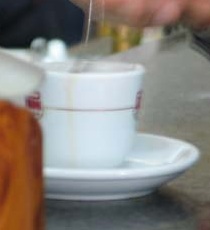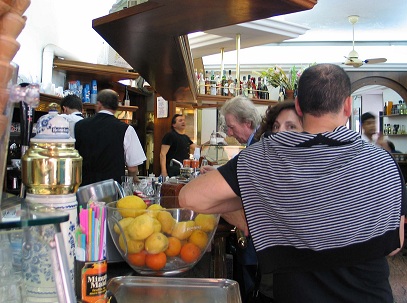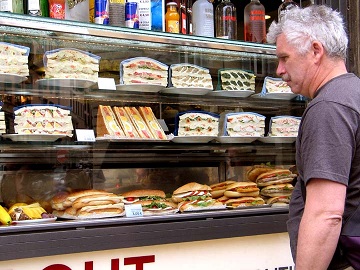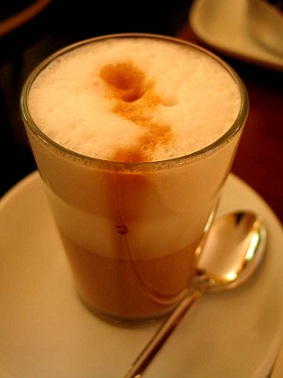Italian Coffee – I Just Want to Find a Cup of Joe
by Nancy Hartman
 Coffee was first introduced to the west by Italian traders in 1600. Specifically in the affluent trading port Venezia (or Venice as it is known by many). Prior to its introduction, coffee was viewed as predominantly a Muslim drink.
Coffee was first introduced to the west by Italian traders in 1600. Specifically in the affluent trading port Venezia (or Venice as it is known by many). Prior to its introduction, coffee was viewed as predominantly a Muslim drink.
Coffee wasn’t readily accepted by Christian Europe and was even considered evil because of the strained relations with the Islamic. That was until Pope Clemet VIII (1536-1605) became a coffee aficionado and allowed free trade and consumption of coffee in the Christian empire.
In Venezia, the first Italian caffe’ shop opened in 1607 and others soon followed. These shops were simply named to reflect what they sold, caffe’. These caffe’s were frequented by Venezia’s intellectuals who would come to drink coffee and sit and discuss worldly affairs. It was also a popular place to go and share in a game of chess which was the game of the Venetian coffee houses.
Coffee eventually spread throughout Italy and became an important staple in the Italian cuisine as we know it today. Does this sound familiar? It should, because a little coffee bean company merged with a little coffee shop in Seattle in 1987 and was branded Starbucks. The Starbucks coffee shop that you know today, was modeled after a caffe’ house in Milano,Italy.
First I should say I don’t drink coffee so I may not be the voice of authority as I speak on coffee. Maybe that is just what this story needs, a neutral perspective that I have on the liquid rush that so many people rely on.
Back in the United States, I often find myself meeting friends for coffee as an excuse to get together. We meet at one of the many local Starbucks, stand in line, while a string of “in the know lingo” drifts over the counter to the barista. “I’ll have a tall, soy, caramel macchiato no whip”, “how about a veniti, skinny, white mocha, tepid please, or ”Give me a triple venti cappuccino, extra hot.”
For a non coffee drinker, like me, it can be an intimidating experience. I have my preferred order planned and call out my request, a tall skinny hot chocolate, no whip, with foam. We pick a table and our name is called a few minutes later. We pick up our drinks and sit back down at a table and talk. Around us business associates are doing business, students studying or busy people, that are running late, rush off to their cars with their to-go cup in hand.
My recent visit to Italy opened my eyes to caffe’. The Starbucks coffee shops that we have on every corner do not resemble most of today’s caffe’ bars in much of Italy.
Italy’s caffe’ bars are plentiful; they are usually in a pedestrian environment. Patrons don’t drive to the coffee shop to meet up, they stroll in from the sidewalk. The caffe’ bars are small with maybe one or two tables that only tourists use. I visited several caffe’ bars in Italy from as far south as Sorrento, heading North to Napoli (Naples), Roma (Rome), Firenze (Florence), Vinci, up to Venezia (Venice), and the process appeared the same.
The barista wipes the bar and tosses a few clean saucers on the bar top with a small spoon. A customer walks in and raises a finger indicating one caffe’. The espresso machine has all nozzles brewing continuously into small ceramic cups. If it is in the morning shortly after the espresso cups hits the saucer, a small pitcher of milk is steamed up and lands nearby, a caffe’ latte. If you ask the barista will whip you up a cappuccino (espresso with foam).
 If it is afternoon, true Italians don’t take their caffe’ with latte (milk). The milk is considered a meal in itself, a true Italian breakfast, similar to a bowl of cereal in the United States.
If it is afternoon, true Italians don’t take their caffe’ with latte (milk). The milk is considered a meal in itself, a true Italian breakfast, similar to a bowl of cereal in the United States.
I sat in a Caffe’ bar for about a half hour watching the process, no one person seems to stay longer than three minutes. The Italian caffe’ bars are similar to a fueling station, a brief experience that has very little resemblance to the original description of the Caffe’ bars from 1607 in Italy.
If you don’t want to stand out as a tourist, which really is impossible not to do, you can look experienced with a few tips to use in a caffe’ bar:
Be careful about the time of day that you request a cappuccino. Caffe’ with milk is only a morning drink.
Do not try ordering a latte’, because it literally translates to milk in Italian. All you will get is a glass of milk
The Italian caffe’ drinkers enjoy their caffe’ lukewarm so it can be quickly drunk and the customer is out the door. If you intend to sit down at the rare table, your caffe’ would be cold because it isn’t a drink meant to be sipped casually. You would also get charged a service fee to sit and be served. Again, you would stand out as a tourist.
Your caffe’ visit is quick, standing up at the bar, as it is economical and fast. Since the shops are so small, once you leave the process repeats with someone new.
 Caffe’ bars in Italy often serve alcohol and sandwiches, which are also consumed while standing. It seems the Italian’s are an economical, people on the go. I always thought that the European’s were a little more laid back than American’s and that our pace was fast. In Italy, there are now larger populations living in small ancient cities. The Italians aren’t lingering over a majority of their meals or snacks these days. It is time to pick up the pace!
Caffe’ bars in Italy often serve alcohol and sandwiches, which are also consumed while standing. It seems the Italian’s are an economical, people on the go. I always thought that the European’s were a little more laid back than American’s and that our pace was fast. In Italy, there are now larger populations living in small ancient cities. The Italians aren’t lingering over a majority of their meals or snacks these days. It is time to pick up the pace!
Interestingly enough, the difference in coffee drinks in Italy seems to be the emphasis on the same three ingredients, Coffee, milk, and foam. With a latte macchiato, the emphasis is on the milk, rather than the coffee.
You probably wonder if I tried the caffe’ while in Italy? Yes, I did! With the help of the barista in the hotel we stayed in, I was introduced to a Latte Macchiato. This is a drink that’s literal translation is, stained milk. It refers to how the drink is made. The milk is steamed and then “stained” by adding a small amount of espresso.  The latte machiato is a layered drink which is prepared by frothing the milk to generous foam. The frothed milk is poured into a glass (not a ceramic mug). The heavier milk sinks to the bottom leaving a layer of thick foam on the top. The espresso, usually significantly less than half a shot, is then added by pouring it gently over the back of a spoon, so the foam is not disturbed. The espresso settles to the bottom below the milk and the foam at the top.
The latte machiato is a layered drink which is prepared by frothing the milk to generous foam. The frothed milk is poured into a glass (not a ceramic mug). The heavier milk sinks to the bottom leaving a layer of thick foam on the top. The espresso, usually significantly less than half a shot, is then added by pouring it gently over the back of a spoon, so the foam is not disturbed. The espresso settles to the bottom below the milk and the foam at the top.
A small macchia is visible, the little spot on the foam where the espresso was added which indicates the drink was a latte macchiato rather than a caffè latte, which is a coffee with milk. When you receive your drink it is a beautiful three layer arrangement visible through the glass and a great starter drink for non caffe’ drinkers.
Italian Coffee Vocabulary List:
caffè (espresso) – a small cup of very strong coffee, i.e., espresso
caffè Americano – American-style coffee, but stronger; weaker than espresso and served in a large cup
caffe’ caldo – hot coffee
caffè corretto – coffee “corrected” with a shot of grappa, cognac, or other spirit
caffè doppio – double espresso
caffè freddo – cold coffee
caffè Hag – decaffeinated coffee
caffè latte – hot milk mixed with coffee and served in a glass for breakfast
caffè macchiato – espresso “stained” with a drop of steamed milk: small version of a cappuccino
caffè marocchino – espresso with a dash of hot milk and cacao powder
caffè stretto – espresso with less water; rocket fuel!
cappuccino – espresso infused with steamed milk and drunk in the morning, but never after lunch or dinner
granita di caffè con panna – frozen, iced beverage (similar to a slush, but ice shavings make it authentic) and topped with whipped cream.
Check out all of Nancy Hartman’s Italian travel articles:
Italian Breads – Daily Pane
Italian Gelato – One Day I Walked Into A Gelateria
More great coffee articles:
Coffee – Java Talk – Learn all about the history of coffee, how to taste coffee, and making coffee. How to Make the Perfect Cup of Coffee – A great dining experience deserves great coffee!
Coffee Drink Calories – How much damage can your favorite coffee drink do in additional calories added to your diet? The fancier the drink, the fancier the calories.
Espresso Machines – Learn about the different Styles for Different Homes.
How To Store Coffee Beans – Coffee bean’s two greatest enemies are air and moisture. Ideally, coffee should be ground, brewed, and consumed quickly to obtain the best flavor.
How To Use a French Press – The most popular coffee maker in Europe and Australia is the classy French Press. Also known as the plunger pot, coffee press, or press-pot. This stylish coffee maker is making in-roads in America, and coffee addicts swear by it.
How To Use A Moka Pot – A Moka Pot is an Italian steam-based stovetop espresso maker that produces a dark coffee almost as strong as that from a conventional espresso maker. Sometimes called the poor man’s espresso and also known as stove-top espresso.
